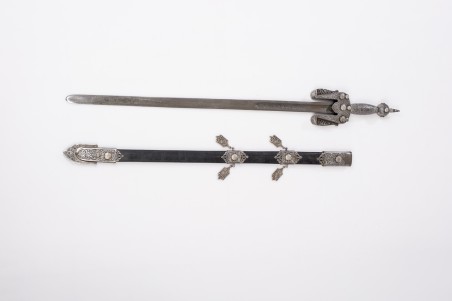SWORD OF BOABDIL, “THE SMALL KING”. 15th Century. Handcrafted in carbon steel with an antiqued finish, made by master swordsmith of Toledo, .
King Mohammed XII, famously known as Boabdil and commonly referred to as “the Small King”, (Granada, Spain, 1464-Vado de Bacuna, Morocco, 1527) was the last Muslim emir of the Nasrid dynasty in Granada (1482-1492). The son of Abu-l-Hasan (Muley Hacén), in 1482 he revolted against his father in Guadix, overthrowing him with the help of the Abencerraje family. However, he was captured by the Catholic Monarchs one year later during his attack at Lucena, and Muley Hacén took advantage of this situation to recover the throne of Granada with the support of his brother, Muhammad ibn Sa’d Al-Zagal, lord of Malaga.
Boabdil was called “The Small King” by the people of Castile and Aragon, and “The Unfortunate” by the Arabs.
To foster discord among the Muslims, the Catholic Monarchs released Boabdil in exchange for his serfdom (Pact of Cordoba, 1483). During the civil war that ensued from 1483 to 1487, Boabdil established his court in Almeria, but was forced to abandon the city and seek shelter from the Catholic Monarchs due to the pressure from Al-Zagal.
In 1487, his father's death and the defeat of his uncle by the Christians in Velez-Malaga enabled him to take hold of the Alhambra and become the sole ruler of Granada. However, the Castilians took advantage of the Muslims’ weaknesses to advance toward the Nasrid kingdom, seizing Malaga and Marbella (1487), Almeria and Guadix (1489), and Baza (1490).
In 1491, the Christians laid siege to Granada, blocking communications along the Genil River by building a fortress at Santa Fe. With no aid from North Africa, the emir of Granada was compelled to sign his capitulation in Santa Fe (25 April 1491) and on 2 January 1492, he handed the city over to the Catholic Monarchs.
“Cry like a woman for what you couldn’t defend like a man” is what, according to legend, Boabdil’s mother told him as he wept over leaving his beloved kingdom of Granada in the hands of the Catholic Monarchs. Strangely enough, he is only remembered for a reproach, which, to make matters worse, was made by his own mother.
Initially confined to Las Alpujarras, in 1493 he fled to Fez, where he died fighting against the Saadian dynasty in the battle that took place at Vado de Bacuna (1527).
CHARACTERISTICS
BLADE. 71 cm long blade, 3 cm wide at the ricasso and 2 cm at the point. Completely forged and tempered by hand in carbon steel by the master . Antiqued finish.
A broad fuller with engraved geometric motifs runs from the ricasso to the forte section of the blade. Below the fuller, the blade is divided into several bevels on each side.
CROSS GUARD. The cross is made of solid iron with chiselled geometric motifs on the entire surface and fretwork at the ends. Attached to the cross guard are 12 damascened medallions in sterling silver: three larger-sized ones with an 8-point star design, and three smaller ones on each side of the cross guard.
GRIP. The grip is also made of solid iron, with chiselling and Arabic designs covering the entire surface. It is threaded on the blade tang.
POMMEL. The round pommel is solid iron with a pointed finial and, like the rest of the sword, it is decorated based on drawings from the period. It has 4 small sterling silver damascened pieces. It is threaded onto the blade tang and riveted to give the sword enhanced strength.
SCABBARD. Handmade in black leather especially for this sword. It has four parts: at the top is a finely chiselled and fretted iron “brocal”, or locket, featuring two damascened pieces in sterling silver, one on each side. Below that, two chiselled and fretted “cantonera” fittings appear at equal distances, bearing two sterling silver damascened medallions attached to either side and two silver pendants at the sides, chiselled with arabesque designs. Finally, the iron “batiente”, or chape, designed to cover the blade point, is chiselled and fretted, featuring four damascened medallions in sterling silver, two on each side.
Sword handmade by the last swordsman master in Toledo. Unique piece.
CRAFTSMANSHIP OF TOLEDO. SPAIN.
Sword of Boabdil, the Small ES734. Handmade by the last swordsman master in Toledo. Unique piece.
ES734
Last items in stock
€8,500.00
Tax included
Transport: Shipment with insurance
Description
Product Details
- Blade size
- 71 cm
- Total size
- 92 cm
- Weight
- 2.590 gr
- Total size with cover
- 95 cm
- Ratio
- 21.40
1 Item


































